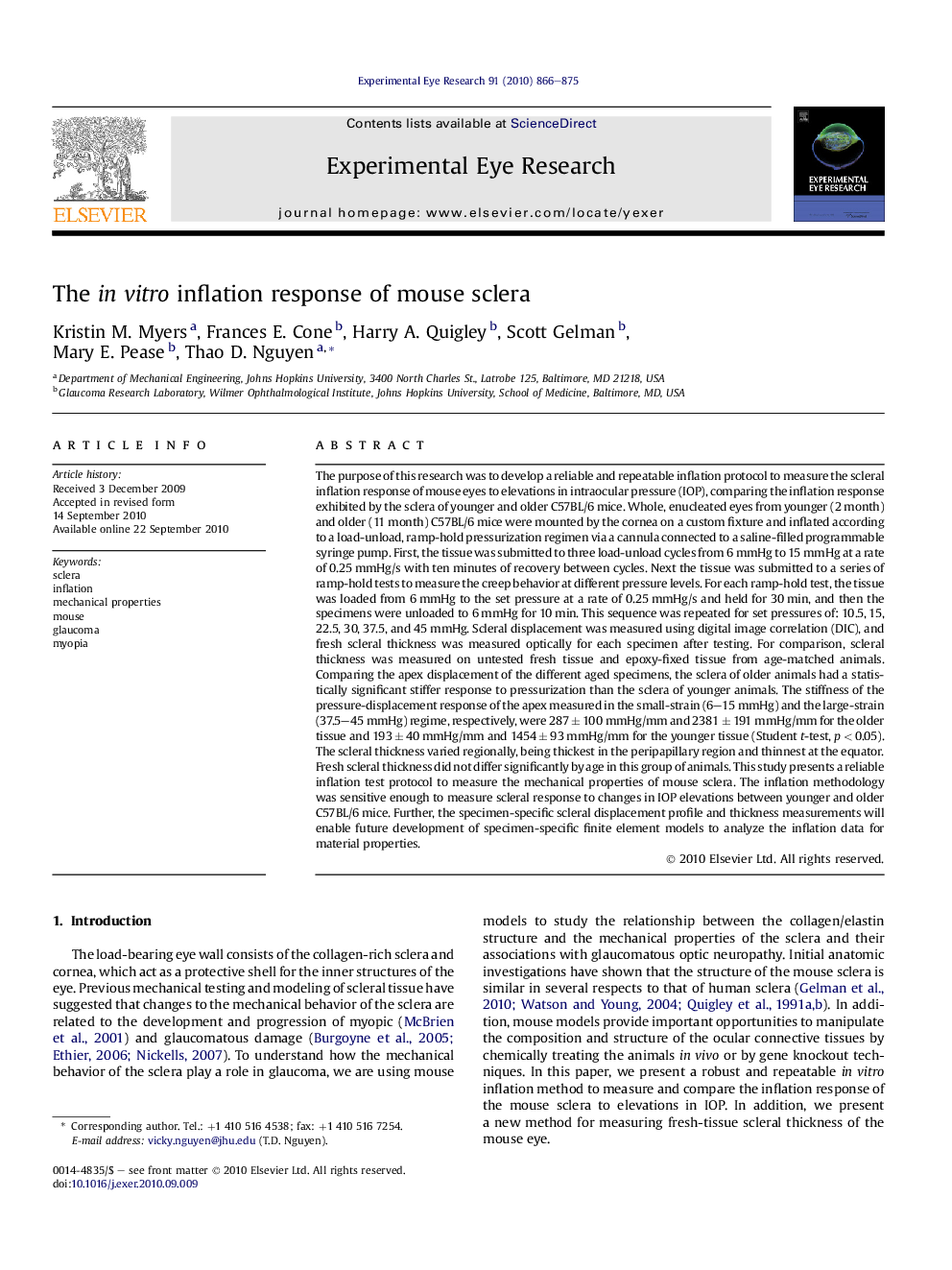| کد مقاله | کد نشریه | سال انتشار | مقاله انگلیسی | نسخه تمام متن |
|---|---|---|---|---|
| 4011750 | 1261161 | 2010 | 10 صفحه PDF | دانلود رایگان |

The purpose of this research was to develop a reliable and repeatable inflation protocol to measure the scleral inflation response of mouse eyes to elevations in intraocular pressure (IOP), comparing the inflation response exhibited by the sclera of younger and older C57BL/6 mice. Whole, enucleated eyes from younger (2 month) and older (11 month) C57BL/6 mice were mounted by the cornea on a custom fixture and inflated according to a load-unload, ramp-hold pressurization regimen via a cannula connected to a saline-filled programmable syringe pump. First, the tissue was submitted to three load-unload cycles from 6 mmHg to 15 mmHg at a rate of 0.25 mmHg/s with ten minutes of recovery between cycles. Next the tissue was submitted to a series of ramp-hold tests to measure the creep behavior at different pressure levels. For each ramp-hold test, the tissue was loaded from 6 mmHg to the set pressure at a rate of 0.25 mmHg/s and held for 30 min, and then the specimens were unloaded to 6 mmHg for 10 min. This sequence was repeated for set pressures of: 10.5, 15, 22.5, 30, 37.5, and 45 mmHg. Scleral displacement was measured using digital image correlation (DIC), and fresh scleral thickness was measured optically for each specimen after testing. For comparison, scleral thickness was measured on untested fresh tissue and epoxy-fixed tissue from age-matched animals. Comparing the apex displacement of the different aged specimens, the sclera of older animals had a statistically significant stiffer response to pressurization than the sclera of younger animals. The stiffness of the pressure-displacement response of the apex measured in the small-strain (6–15 mmHg) and the large-strain (37.5–45 mmHg) regime, respectively, were 287 ± 100 mmHg/mm and 2381 ± 191 mmHg/mm for the older tissue and 193 ± 40 mmHg/mm and 1454 ± 93 mmHg/mm for the younger tissue (Student t-test, p < 0.05). The scleral thickness varied regionally, being thickest in the peripapillary region and thinnest at the equator. Fresh scleral thickness did not differ significantly by age in this group of animals. This study presents a reliable inflation test protocol to measure the mechanical properties of mouse sclera. The inflation methodology was sensitive enough to measure scleral response to changes in IOP elevations between younger and older C57BL/6 mice. Further, the specimen-specific scleral displacement profile and thickness measurements will enable future development of specimen-specific finite element models to analyze the inflation data for material properties.
Research highlights
► This paper presents the first experimental protocol for in vitro inflation testing of intact mouse sclera and reports the inflation response and fresh-tissue thickness measurements comparing younger (2 month) and older (11 month) C57BL/6 mouse eye specimens. The mechanical response of the sclera to increases in pressure, given by the pressure-displacement curves for both younger and older specimens, was non-linear and time-dependent. We found that the thickness of fresh scleral sections was largest in the peripapillary region, thinnest in the equator, and intermediate at the limbus. In the study presented here, we found a statistically significant difference in the inflation response between younger and older C57BL/6 mouse sclera, with younger tissue more compliant than older specimens from the same mouse strain.
Journal: Experimental Eye Research - Volume 91, Issue 6, December 2010, Pages 866–875